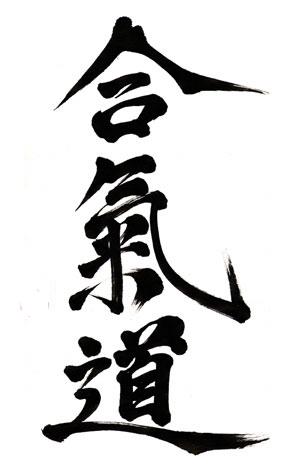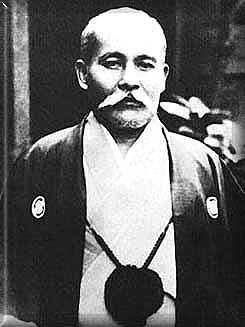









|
|
|
|
|
|
Ueshiba Aikido
is a Japanese martial art focused on self defense and personal
development. It was developed during the 20th century by Morihei
Ueshiba from older arts, particularly Daito Ryu, and stresses
energetically harmonizing with an attacker's movements to neutralize
the attack. Consequently, it is less dependent on size and strength
than other forms of self defense. Besides providing an effective means
of self defense, it is an enjoyable way to get exercise, develop
mental discipline and self esteem, and reduce stress. The principles
of aikido are also excellent for use in everyday life for conflict
resolution.
(Nihon Goshin
Aikido was also developed from Daito Ryu about the same time. It is,
however, historically distinct from the style taught by the Ueshiba
family, from which the style taught at Enmei Dojo evolved.)
Aikido is about
connection and attitude. Connection is essential if we are to do
technique, and also in everyday life. Without connection, we are
unable to affect uke, or to relate to people around us. When we are
attacked, somebody is trying to make a connection with us, but a
connection they control to our detriment. We can accept the attack so
that we can make a connection, but it must be on our terms, and must
be used to contain and ameliorate violence. There is more than enough
violence in the world, and we certainly do not want to create more.
|
 Aikido O Sensei
- Morihei Ueshiba |
| |
|
Often, through
fear, we work to prevent the connection occurring, then there is
nothing we can do to control the attacker or prevent the next attack.
Instead, we must welcome the attack, while not receiving more of the
power of the attack than we can handle. Once we have made this
connection, we want to maintain it, controlling it to limit the
attacker's options for renewing the attack, and using it to undermine
his position so that we can bring about a peaceful resolution of the
aggression. This sounds pacifistic, yet in practice demands a lot of
nage, mentally, physically, and spiritually.
We would prefer
that the result of technique is a de-escalation of violence. Ideally,
both an attacker and the person he attacked would walk away. To even
attempt to do this, an aikidoka needs to have strong technique, both
as nage and uke.
Ukemi is often
neglected as merely what uke does to survive. Yet ukemi is a major
part of aikido. Uke should attack and keep on attacking. Even if the
attack is soft, to allow a smaller or less experienced person to
practice, it should be correct and relentless.
|
| |
There are
many flavors of aikido, Aikikai (e.g. AAA, ASU, Iwama, and USAF), Ki
Society, Shodokan (Tomiki), and Yoshinkan. Particularly through
Aikido-L
seminars we have tasted many of these. All of
them have something to offer. Ki Society generally stresses non
resistance, flowing. Yoshinkan generally teaches precision and power.
Tomiki has included some ideas from judo, and involves competition.
Contrary to popular belief, O Sensei was not against competition as a
training tool, though he seems to have had contempt for the idea that
anything significant could be decided by sports competition. Aikikai
covers the middle ground, and encompasses a lot of variety, largely
through the efforts of the Second Doshu, Kisshomaru Ueshiba, in
encouraging all aikidoka to work together.
|
|
Our approach to
aikido is eclectic, taking ideas from everywhere, but forging them
into a harmonious whole. Our Orlando Police Department school takes a
more martial approach, due to many of the students using aikido in
their jobs. Dr Drysdale began in a quite martial style in England,
and has been working to retain the martial effectiveness while making
the art work better for smaller people. Dr Spitz is only 110 lbs, and
has to do techniques somewhat differently from Dr Drysdale at 140 lbs,
and much differently from somebody weighing in at 250 lbs. O Sensei
was short - about 5 feet tall - but very strong, reportedly weighing
about 180 lbs.
There are a
number of keys to aikido working effectively. A strong attitude is
essential. (It is the size of the fight in the dog, not the size of
the dog in the fight.) Good technique is vital. Kuzushi is
critical - and this involves sente (taking the initiative), mechanical
position, and leverage.
Sente. You must
take charge from before physical contact occurs. If you react to
physical contact, you will be too late and will lose.
Mechanical
position involves both where uke is and where nage is, particularly
the relationship between them. If nage meets uke and pushes against
uke directly, the strongest one wins. No technique is involved. If
nage pushes from off the line of attack, he can apply his force
against the end of uke's arm and thus effortlessly change uke's
position and posture. If nage is early or late, he can also avoid
conflicting with uke's strength.
Leverage is used
when nage applies his strength against uke so that uke's body
mechanics multiply it's effectiveness. Thus, when nage flexes uke's
wrist and uses his hand to rotate uke's forearm, he can achieve a
mechanical advantage of perhaps four to one.
Individually,
these examples are trivial. When an advanced aikidoka applies them
and others correctly, the result is a subtle undermining of uke's
posture, leading to greater and greater difficulties for him until he
is thrown (largely by gravity) or immobilized on the mat.
Strength is an
interesting thing in aikido. As a beginning student 30 years ago at
the University of Reading, I was admonished not to use strength by
people who were clearly using far more strength than I was. If you
are strong enough, you don't need aikido. I believe that aikido is
the efficient use of strength. Straining is bad, because it can
injure you and is probably an indication that your technique is not
sufficiently advanced to do the technique without straining. Thus, it
is good practice to use as little strength as possible on the mat. In
real life, you may need to use more strength than is ideal.
|
|
Aikido is
differentiated from other martial arts by the technical repertoire,
its history, and its ethics. None of these are absolutes except the
historical connection to the Ueshiba family. There are atemi
(strikes) in aikido as there are in karate. The throws and holds are
somewhat similar to Kodokan judo. However, the technical focus of
aikido is somewhat different from other arts.
The ethics of
aikido are to spread harmony around the world. This is perhaps the
most important reason to practice it.
|
|
For
additional information about Dr Drysdale's ideas on aikido, developed
over 40 years of martial arts training, see
Spitz Publishing
|
|
|